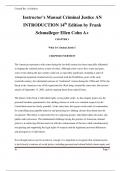Exam (elaborations)
Instructor’s Manual Criminal Justice AN INTRODUCTION 14th Edition by Frank Schmalleger Ellen Cohn A+
- Course
- Institution
- Book
Instructor’s Manual Criminal Justice AN INTRODUCTION 14th Edition by Frank Schmalleger Ellen Cohn A+..
[Show more]




